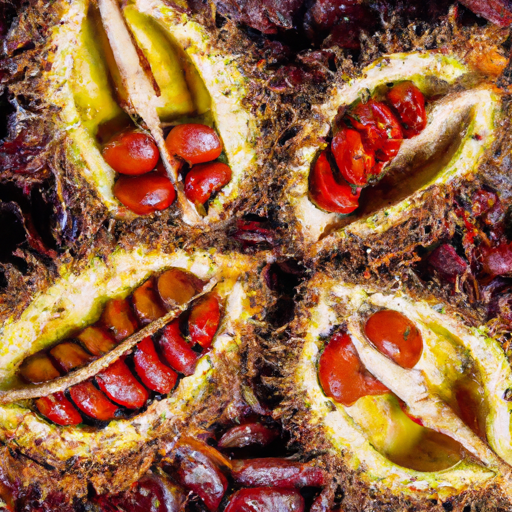All About Achiote Seeds: A Burst of Flavor in Your Kitchen
Known for their vibrant reddish-orange color and earthy flavor, achiote seeds have been a staple in Latin American, Caribbean, and Filipino cuisines for centuries. These tiny seeds, derived from the achiote tree (Bixa orellana), add depth and complexity to a wide range of dishes. In this blog post, we’ll explore the taste, common uses, nutritional value, and fascinating history of achiote seeds.
Taste and Aroma: A Flavorful Adventure
Achiote seeds possess a unique flavor profile that can be described as nutty, slightly peppery, and subtly sweet. When cooked, they release a captivating aroma that is both warm and mysterious, reminiscent of the lush tropical regions where they originate.
Common Uses in Cooking
Traditional Dishes:
Achiote seeds are a staple ingredient in many traditional recipes. They are commonly used in dishes such as:
- Recado Rojo: A traditional marinade from the Yucatan region in Mexico, used for seasoning meats and seafood.
- Adobo: The Filipino version of a marinade or sauce, where achiote seeds are combined with vinegar, soy sauce, garlic, and other spices.
- Cochinita Pibil: A traditional Mexican slow-roasted pork dish, marinated with achiote paste to achieve its deep, rich flavor.
Spice Blends and Pastes:
Besides their direct use, achiote seeds can be ground into a fine powder or transformed into paste form, commonly referred to as “achiote paste” or “annatto paste.” These versatile forms are widely used in various applications, including:
- Sazon: A popular Latin American spice blend that adds vibrant color and flavor to rice, soups, stews, and beans.
- Mole: A complex Mexican sauce made with a variety of ingredients, including achiote seeds, dried chilies, nuts, and spices.
- Fish and Meat Rubs: Achiote spice rubs add a distinctive flavor and vibrant color to grilled fish, chicken, and beef.
Nutritional Value
Achiote seeds not only add a burst of flavor to your dishes but also offer some nutritional benefits. Here are some highlights:
- Vitamins and Minerals: Achiote seeds are a good source of vitamins and minerals, including vitamin C, vitamin E, iron, calcium, and potassium.
- Antioxidants: They contain natural antioxidants, such as carotenoids, that help protect the body against oxidative stress.
- Anti-inflammatory Properties: Studies suggest that achiote seeds may possess anti-inflammatory properties, aiding in overall health and well-being.
Fascinating History and Facts
- Ancient Roots: Achiote seeds have a rich history and have been used for culinary and cosmetic purposes for thousands of years. Indigenous communities in the Americas traditionally used achiote seeds as a natural colorant for body paint, textiles, and even as sunscreen.
- Colonial Influence: The use of achiote spread globally during the colonial era when Spanish colonizers discovered its vibrant color and unique flavor. They brought back achiote seeds to Europe and introduced them to various cuisines, forever ingraining them into culinary culture.
- Cultural Symbolism: In some Latin American countries, achiote seeds hold cultural significance and are used in traditional celebrations and ceremonies as a symbol of luck, love, and protection.
So, whether you’re seeking to add a touch of exotic flair to your dishes or explore the diverse cuisines of Latin America and beyond, achiote seeds are a must-have in your culinary repertoire. Their vibrant color, nutty flavor, and intriguing history make them an ingredient worth experimenting with. Unlock the secrets of achiote seeds and elevate your cooking to new heights!
Note: Achiote seeds are also known by various names, including annatto seeds, bija, and achuete seeds.
Achiote Seeds
Origin: Achiote seeds, also known as annatto seeds, come from the achiote tree (Bixa orellana), which is native to tropical regions of Central and South America. It is believed that the achiote tree originated in the Amazon rainforest.
Common Uses: Achiote seeds are commonly used as a natural coloring agent and flavor enhancer in many cuisines. The seeds are typically ground into a powder or steeped in oil to extract the vibrant red-orange pigment known as annatto. This pigment is used to add a colorful touch to dishes such as rice, stews, soups, sauces, and marinades. Achiote seeds are also used in traditional dishes like Mexican cochinita pibil and Filipino kare-kare.
Nutritional Benefits: While achiote seeds are primarily used for their color and flavor, they also offer some nutritional benefits. They are a good source of antioxidants, including carotenoids like beta-carotene, which is converted by the body into vitamin A. Achiote seeds also contain some minerals like calcium, iron, and magnesium. However, it’s important to note that the seeds are usually used in small quantities, so their nutritional contribution may be minimal.
Unique Properties: Besides their culinary uses, achiote seeds have been used for their medicinal properties as well. In traditional medicine, achiote seeds have been used to treat various conditions, including digestive issues, bronchitis, and skin problems. The seeds contain compounds that have shown antioxidant, anti-inflammatory, and antimicrobial properties in some studies.
Historical Significance: Achiote seeds have a long history of use dating back to pre-Columbian times. They were highly regarded by the indigenous peoples of the Americas and were even used as a form of currency. Achiote seeds were also used for body paint, as they were believed to have protective and ceremonial significance. The dye extracted from the seeds was used to color fabrics and was considered sacred by some Native American tribes.
Please note that while achiote seeds have been used traditionally for various purposes, it’s always important to consult a healthcare professional for specific medical advice or concerns.




Use the share button below if you liked it.
It makes me smile, when I see it.